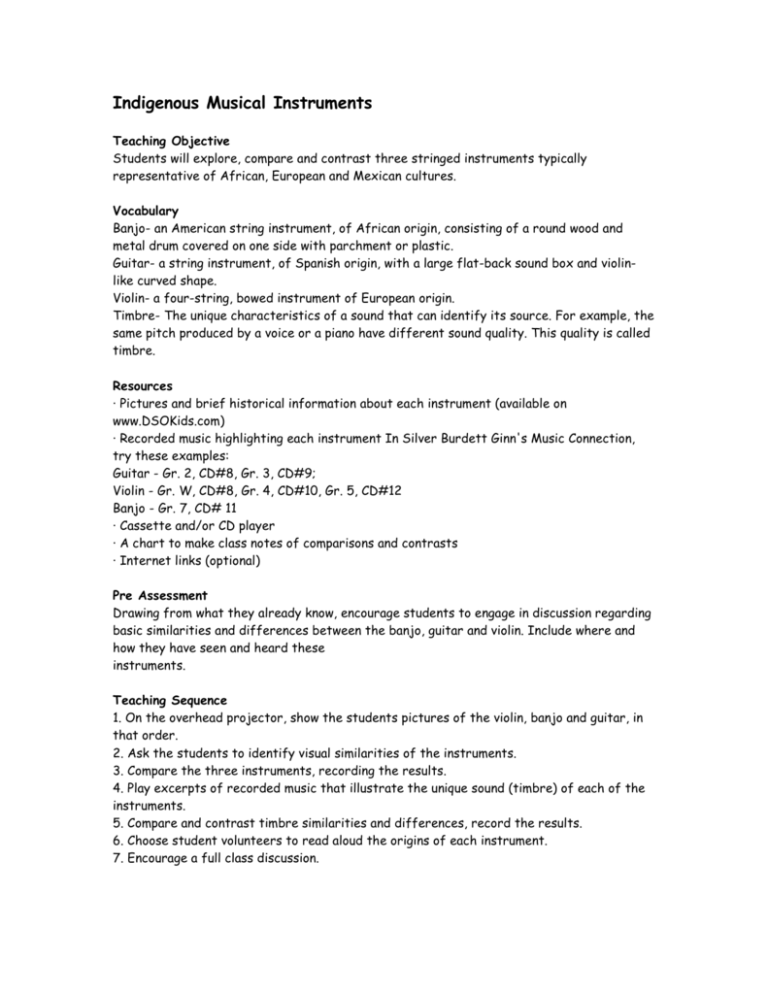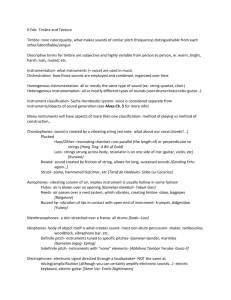Indigenous Musical Instruments
advertisement

Indigenous Musical Instruments Teaching Objective Students will explore, compare and contrast three stringed instruments typically representative of African, European and Mexican cultures. Vocabulary Banjo- an American string instrument, of African origin, consisting of a round wood and metal drum covered on one side with parchment or plastic. Guitar- a string instrument, of Spanish origin, with a large flat-back sound box and violinlike curved shape. Violin- a four-string, bowed instrument of European origin. Timbre- The unique characteristics of a sound that can identify its source. For example, the same pitch produced by a voice or a piano have different sound quality. This quality is called timbre. Resources · Pictures and brief historical information about each instrument (available on www.DSOKids.com) · Recorded music highlighting each instrument In Silver Burdett Ginn's Music Connection, try these examples: Guitar - Gr. 2, CD#8, Gr. 3, CD#9; Violin - Gr. W, CD#8, Gr. 4, CD#10, Gr. 5, CD#12 Banjo - Gr. 7, CD# 11 · Cassette and/or CD player · A chart to make class notes of comparisons and contrasts · Internet links (optional) Pre Assessment Drawing from what they already know, encourage students to engage in discussion regarding basic similarities and differences between the banjo, guitar and violin. Include where and how they have seen and heard these instruments. Teaching Sequence 1. On the overhead projector, show the students pictures of the violin, banjo and guitar, in that order. 2. Ask the students to identify visual similarities of the instruments. 3. Compare the three instruments, recording the results. 4. Play excerpts of recorded music that illustrate the unique sound (timbre) of each of the instruments. 5. Compare and contrast timbre similarities and differences, record the results. 6. Choose student volunteers to read aloud the origins of each instrument. 7. Encourage a full class discussion. Culminating Activities 1. Encourage students to create stories of actual or imagined personal experiences with one or more of the instruments. They should include the significance of the instrument within their family or ethnic culture. 2. Encourage students to write a story in the first person, in the voice of one of the instruments. Evaluation Did the students demonstrate an understanding of similarities and differences between the violin, banjo and guitar? Extension Activity Encourage students to select one or more musical instruments of significance in their heritage and/or culture and bring a cassette tape recording, compact disc or actual instrument to class. Provide sharing and listening opportunities. Co-Curricular Connections/TEKS Fine Arts- Music: 117.12 3.1A,B, 3.5A,C 3.6A; 117.15 4.1A,B , 4.5A,D, 4.6A,C; 117.18 5.1A,B, 5.5A,E, 5.6A,B; 117.33 6.1B, 6.5A,D, 6.6A Language Arts: 110.5 1A,B,C,D, 2A,B, 8A, 13A,B, 14A,B; 110.6 1A,B,C, 4A,B,C, 9A,E, 14A,B,C, 15A,D,E, 110.7 1A,B,C, 4A,B,C, 14A,B,C, 15A.D,E; 110.21 1A,B,C, 4A,B,C, 9A, 14A,B,C, 15A,D,E Social Studies: 113.5 2B, 12B, 17A,B,C; 113.6 20B,C, 23A,B,C,D,E; 113.7 22A,B, 26A,B,C,D,E; 113.22 2A, 15A,B,C, 16A, 17A,C,D,E,F, 18A,B,C,D, 22A,B,C,D,E











